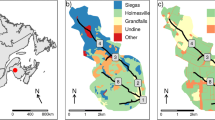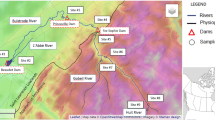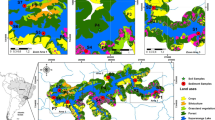Abstract
Purpose
Sediment fingerprinting with elemental tracers is widely used to identify sources of sediment to rivers. However, due to the need to isolate large amounts of suspended sediment, this approach can be difficult to implement in remote locations, such as the Mara River in Kenya, where high (and increasing) sediment loads are of concern.
Materials and methods
We report several innovations that allowed us to carry out sediment fingerprinting in a portion (>6,500 km2) of the Mara River Basin. First, we utilized sediment-laden filters (sediment mass ∼0.1 g) for our river samples, rather than the traditional approach of extracting >1 g of sediment from large volumes of water. This allowed us to easily collect flow-weighted samples, and to process and analyze samples without access to centrifugation equipment. We carried out extensive quality control tests to ensure that we could reproducibly measure elemental concentrations of sediment trapped on filters. Second, we modified a readily available Bayesian inference mixing model (Stable Isotope Analysis in R) to create source signatures and to apportion downstream samples to sources. Third, we included hippo feces as a potential source, given the critical role that large wildlife plays in this ecosystem.
Results and discussion
We found that: (1) sediment captured by filtration can be digested and analyzed reproducibly and used in sediment fingerprinting; (2) our four sources (three geographic categories and hippo feces) were reasonably well-separated in their signatures; (3) the three sub-basins all contributed substantially to sediment loading in the Mara; and (4) hippo feces contributed a small, but measurable, proportion of sediment in this system.
Conclusions
Sediment-laden filters can be used successfully in identifying sediment sources through fingerprinting. The modified method of sediment fingerprinting should prove useful in other remote river basins. Our results support the hypothesis that the Upper Mara is important in supplying sediments to the river, while also highlighting the Talek sub-basin as a major contributor.





Similar content being viewed by others
References
Borcard D, Gillet F, Legendre P (2011) Numerical ecology with R. Springer, New York
Bouyoucos GJ (1936) Directions for making mechanical analysis of soils by the hydrometer method. Soil Sci 42:225–230
Collins AL, Walling DE, Leeks GJL (1997) Source type ascription for fluvial suspended sediment based on a quantitative composite fingerprinting technique. Catena 29:1–27
Collins AL, Walling DE, Leeks GJL (1998) Use of composite fingerprints to determine the provenance of the contemporary suspended sediment load transported by rivers. Earth Surf Process Landf 23:31–52
Collins AL, Walling DE, Sichingabula HM, Leeks GJL (2001) Suspended sediment source fingerprinting in a small tropical catchment and some management implications. Applied Geography 21:387–412
Collins AL, Walling DE, Webb L, King P (2010) Apportioning catchment scale sediment sources using a modified composite fingerprinting technique incorporating property weightings and prior information. Geoderma 155:249–261
Davis CM, Fox JF (2009) Sediment fingerprinting: review of the method and future improvements for allocating nonpoint source pollution. J Environ Eng-ASCE 135(7):490–504
Dutton CL (2012) Sediment fingerprinting in the Mara River Basin; Uncovering relationships between wildlife, tourism and non-point source pollution. MESc Thesis. Yale University School of Forestry and Environmental Studies, New Haven, CT, USA
Edwards TK, Glysson GD (1999) Field Methods for Measurement of Fluvial Sediment. In: Techniques of Water-Resources Investigations of the U.S. Geological Survey. Reston, Virginia, USA, p 97
Evrard O, Navratil O, Ayrault S, Ahmadi M, Nemery J, Legout C, Lefevre I, Poirel A, Bonte P, Esteves M (2011) Combining suspended sediment monitoring and fingerprinting to determine the spatial origin of fine sediment in a mountainous river catchment. Earth Surf Process Landf 36:1072–1089
Gellis AC, Walling DE (2011) Sediment source fingerprinting (tracing) and sediment budgets as tools in targeting river and watershed restoration programs. In: Stream Restoration in Dynamic Fluvial Systems: Scientific Approaches, Analyses, and Tools, vol 194. Geophys. Monogr. Ser. AGU, Washington, DC, USA, pp 263–291
Goddard DL (2011) Data validation standard operating procedures for contract laboratory program inorganic data by inductively coupled plasma–atomic emission spectroscopy and inductively coupled plasma–mass spectroscopy. USEPA Region 4
Grey J, Harper DM (2002) Using stable isotope analyses to identify allochthonous inputs to Lake Naivasha mediated via the hippopotamus gut. Isot Environ Health Stud 38:245–250
Horowitz AJ (1991) A primer on sediment-trace element chemistry. 2nd edn. Lewis
Horowitz AJ, Elrick KA, Smith JJ (2001) Estimating suspended sediment and trace element fluxes in large river basins: methodological considerations as applied to the NASQAN programme. Hydrol Process 15:1107–1132
Kanga EM, Ogutu JO, Olff H, Santema P (2011) Population trend and distribution of the vulnerable common hippopotamus Hippopotamus amphibius in the Mara Region of Kenya. Oryx 45:20–27
Kemp P, Sear D, Collins A, Naden P, Jones I (2011) The impacts of fine sediment on riverine fish. Hydrol Process 25:1800–1821
Kiragu GM (2009) Assessment of suspended sediment loadings and their impact on the environmental flows of upper transboundary Mara River, Kenya. Jomo Kenyatta University of Agriculture and Technology, Nairobi
Krhoda GO (2006) The hydrology of the Mara River. Mara River catchment basin initiative preliminary phase: project development and stakeholders analysis. WWF-EARPO, Nairobi
Lamprey RH, Reid RS (2004) Special paper: expansion of human settlement in Kenya’s Maasai Mara: what future for pastoralism and wildlife? J Biogeogr 31:997–1032
LVBC, WWF-ESARPO (2010) Assessing reserve flows for the Mara River, Kenya and Tanzania. Lake Victoria Basin Commission of the East African Community, Kisumu, Kenya
LVSC (2008) Catchment management strategy—DRAFT. Government of Kenya, Kisumu
Martínez-Carreras N, Krein A, Udelhoven T, Gallart F, Iffly J, Hoffmann L, Pfister L, Walling D (2010) A rapid spectral-reflectance-based fingerprinting approach for documenting suspended sediment sources during storm runoff events. J Soils Sediments 10:400–413
Mati BM, Mutie S, Gadain H, Home P, Mtalo F (2008) Impacts of land-use/cover changes on the hydrology of the transboundary Mara River, Kenya/Tanzania. Lakes & Reservoirs: Research & Management 13:169–177
McCarthy MA (2007) Bayesian methods for ecology. Cambridge University Press, Cambridge
McCartney B (2010) Evaluation of water quality and aquatic ecosystem health in the Mara River Basin, East Africa. Florida International University, Miami
Morrison MA, Benoit G (2001) Filtration artifacts caused by overloading membrane filters. Environ Sci Technol 35:3774–3779
Motha JA, Wallbrink PJ, Hairsine PB, Grayson RB (2003) Determining the sources of suspended sediment in a forested catchment in southeastern Australia. Water Resour Res 39:1056. doi:10.1029/2001WR000794
Mukundan R, Radcliffe DE, Ritchie JC, Risse LM, McKinley RA (2010) Sediment fingerprinting to determine the source of suspended sediment in a Southern Piedmont Stream. J Environ Qual 39:1328–1337
Mukundan R, Walling DE, Gellis AC, Slattery MC, Radcliffe DE (2012) Sediment source fingerprinting: transforming from a research tool to a management tool. J Amer Water Resour Assoc 48:1241–1257
Naiman RJ, Rogers KH (1997) Large animals and system level characteristics in river corridors. Bioscience 47:521–529
Parnell AC, Inger R, Bearhop S, Jackson AL (2010) Source partitioning using stable isotopes: coping with too much variation. PLoS One 5:e9672. doi:10.1371/journal.pone.0009672
Phillips JM, Russell MA, Walling DE (2000) Time-integrated sampling of fluvial suspended sediment: a simple methodology for small catchments. Hydrol Process 14:2589–2602
Russell MA, Walling DE, Hodgkinson RA (2001) Suspended sediment sources in two small lowland agricultural catchments in the UK. J Hydrol 252(1-4):1–24. doi:10.1016/s0022-1694(01)00388-2
Singler H, McClain ME (2006) A water quality baseline assessment of the Mara River basin. Florida International University, Kenya-Tanzania
Slattery MC, Burt TP (1997) Particle size characteristics of suspended sediment in hillslope runoff and stream flow. Earth Surf Process Landf 22:705–719
Small IF, Rowan JS, Franks SW (2002) Quantitative sediment fingerprinting using a Bayesian uncertainty estimation framework. In: Structure, function and management implications of fluvial sedimentary systems. IAHS Publ 276. IAHS, Wallingford, pp 443–450
Small IF, Rowan JS, Franks SW, Wyatt A, Duck RW (2004) Bayesian sediment fingerprinting provides a robust tool for environmental forensic geoscience applications. Geological Society, London, Special Publications 232:207–213
Sombroek WG, Braun HMH, Van der Pouw BJA (1982) Exploratory soil map and agro-climatic zone map of Kenya. Kenya Soil Survey, Nairobi
Terer JK (2005) The study of hydrologic characteristics and management practices in agricultural river catchments: the case of Nyongores River catchment, Mara River basin. Moi University, Eldoret
UNESCO (1983) Study of the relationship between sediment transport and water quality. UNESCO Technical Papers in Hydrology, vol 26. UNESCO, Paris
USEPA (1996) SW-846 Method 3052: microwave assisted acid digestion of siliceous and organically based matrices. U.S. Gov. Print Office, Washington
USEPA (2007) SW-846 Method 6020A: inductively coupled plasma-mass spectrometry. U.S. Gov. Print Office, Washington
Walling DE (2005) Tracing suspended sediment sources in catchments and river systems. Sci Total Environ 344:159–184
Walling DE, Owens PN, Leeks GJL (1999) Fingerprinting suspended sediment sources in the catchment of the River Ouse, Yorkshire, UK. Hydrol Process 13:955–975
Walling DE, Collins AL, Sichingabula HM, Leeks GJL (2003) Use of reconnaissance measurements to establish catchment sediment budgets: a Zambian example. In: DeBoer DH, Froehlich W, Mizuyama T, Pietroniro A (eds) Erosion prediction in ungauged basins: integrating methods and techniques, IAHS Publ 279. IAHS, Wallingford, pp 3–12
Wolanski E, Gereta E (2001) Water quantity and quality as the factors driving the Serengeti ecosystem, Tanzania. Hydrobiologia 458:169–180
Wolf RE, Denoyer E, Grosser Z (2002) Application note: SW-846 method 6020 for the analysis of soils and sediments by ICP-MS
Acknowledgments
This study was supported by the Tropical Resources Institute, the Carpenter-Sperry Fund, and the Lindsay Fellowship. The Kenya National Council for Science and Technology authorized this research. Musombi Kibberenge and the National Museums of Kenya provided logistical support. Brian Heath and the Mara Conservancy, Rekero Camp, Olerai Mara Farms, and Patrick Beresford of Governor’s Camp provided assistance in the field. Amanda Subalusky, J.J. Weis, and David Post from the Yale Ecology and Evolutionary Biology department assisted with field sampling. Three anonymous reviewers provided suggestions that greatly improved this manuscript.
Author information
Authors and Affiliations
Corresponding author
Additional information
Responsible editor: Rajith Mukundan
Rights and permissions
About this article
Cite this article
Dutton, C., Anisfeld, S.C. & Ernstberger, H. A novel sediment fingerprinting method using filtration: application to the Mara River, East Africa. J Soils Sediments 13, 1708–1723 (2013). https://doi.org/10.1007/s11368-013-0725-z
Received:
Accepted:
Published:
Issue Date:
DOI: https://doi.org/10.1007/s11368-013-0725-z




